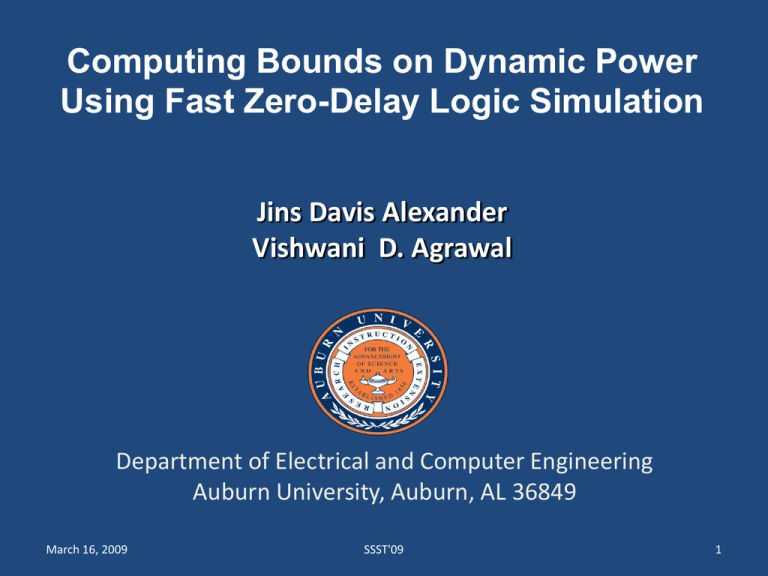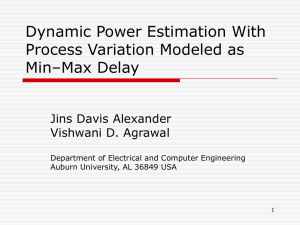Computing Bounds on Dynamic Power Using Fast Zero-Delay Logic Simulation
advertisement

Computing Bounds on Dynamic Power Using Fast Zero-Delay Logic Simulation Jins Davis Alexander Vishwani D. Agrawal Department of Electrical and Computer Engineering Auburn University, Auburn, AL 36849 March 16, 2009 SSST'09 1 Objective • Determine power dissipation in a digital CMOS circuit. March 16, 2009 SSST'09 2 Components of Power • Dynamic – Signal transitions • Logic activity • Glitches – Short-circuit • Static – Leakage March 16, 2009 Ptotal = Pdyn + Pstat = Ptran + P + Pstat sc SSST'09 3 Power Per Transition isc R VDD Dynamic Power Vo Vi = CLVDD2/2 + Psc CL R Ground March 16, 2009 SSST'09 4 Number of Transitions March 16, 2009 SSST'09 5 Problem Statement • Problem - Estimate dynamic power consumed in a CMOS circuit for: – A set of input vectors – Delays subjected to process variation • Challenge - Existing method, Monte Carlo simulation, is expensive. • Find a lower cost solution. March 16, 2009 SSST'09 6 Bounded (Min-Max) Delay Model IV FV EA • • • • LS FV EA LS EA is the earliest arrival time LS is the latest stabilization time IV is the initial signal value FV is the final signal value EAsv=-∞ Driving value EAdv LSsv=∞ LSdv EAdv=-∞ Sensitizing value March 16, 2009 IV EAsv [d, D] LSdv=∞ LSsv SSST'09 7 Example d d March 16, 2009 SSST'09 D D 8 Finding Number of Transitions 3 14 7 5 8 10 12 10 12 14 2, 2 [mintran,maxtran] [0,2] 3 EA 5 EA 14 6 LS [0,4] 1, 3 EA 17 LS 17 LS where mintran is the minimum number of transitions and maxtran the maximum number of transitions. March 16, 2009 SSST'09 9 Estimating maxtran • Nd: First upper bound is the largest number of transitions that can be accommodated in the ambiguity interval given by the gate delay bounds and the (IV, FV) output values. • N: Second upper bound is the sum of the input transitions as the output cannot exceed that. Further modify it as N=N–k where k = 0, 1, or 2 for a 2-input gate and is determined by the ambiguity regions and (IV, FV) values of inputs. • The maximum number of transitions is lower of the two upper bounds: maxtran = min (Nd, N) March 16, 2009 SSST'09 10 First Upper Bound, Nd Nd = 1 + (LS – EA)/d └ ┘ d d, D EA March 16, 2009 SSST'09 LS 11 Examples of maxtran Nd = 1 + (18 – 3)/0 = ∞ N=4+4=8 maxtran=min (Nd, N) = 8 Nd = 1 + (23 – 6)/3 = 6 N=4+4=8 maxtran=min (Nd, N) = 6 March 16, 2009 SSST'09 12 Example: maxtran With Non-Zero k [n1 = 6] EAsv = - ∞ [n1 + n2 – k = 8 ] , LSdv = ∞ EAdv EAsv = - ∞ LS where k = 2 LSsv [n2 = 4] EAdv EA LSdv = ∞ LSsv [6] [6+4–2=8] [4] March 16, 2009 SSST'09 13 Simulation Methodology • d, D = nominal delay ± Δ% • Three linear-time passes for each input vector: First pass: zero delay simulation to determine initial and final values, IV and FV, for all signals. Second pass: determines earliest arrival (EA) and latest stabilization (LS) from IV, FV values and bounded gate delays. Third pass: determines upper and lower bounds, maxtran and mintran, for all gates from the above information. March 16, 2009 SSST'09 14 Zero-Delay Vs. Event-Driven Simulation 9000 8000 Execution Time (secs) 7000 6000 5000 Event driven simulation 4000 Min-Max Simulation 3000 2000 1000 0 357 514 880 1161 1667 2290 2416 3466 Number of gates March 16, 2009 SSST'09 15 Maximum Power • Monte Carlo Simulation vs. Min-Max analysis for circuit C880. 100 sample circuits with + 20 % variation were simulated for each vector pair (100 random vectors). R2 is coefficient of determination, equals 1.0 for ideal fit. March 16, 2009 SSST'09 16 Minimum Power R2 is coefficient of determination, equals 1.0 for ideal fit. March 16, 2009 SSST'09 17 Average Power 10 9 Monte Carlo average power (mW) R2 = 0.9527 8 7 6 5 4 3 R2 is coefficient of determination, equals 1.0 for ideal fit. 2 1 0 0 2 4 6 8 10 MIN - MAX m ean pow er (m W) March 16, 2009 SSST'09 18 C880: Monte Carlo vs. Bounded Delay Analysis 80000 1000 Random Vectors, 1000 Sample Circuits 70000 Frequency 60000 50000 40000 30000 20000 10000 2. 13 7 2. 74 74 3. 35 79 3. 96 83 4. 57 88 5. 18 92 5. 79 96 6. 41 01 7. 02 05 7. 63 1 8. 24 14 8. 85 19 9. 46 23 10 .0 73 10 .6 83 11 .2 94 1. 52 65 0 Power (mW) Monte Carlo Simulation Bounded Delay Analysis Min Power (mW) Max Power (mW) CPU Time (secs) Min Power (mW) Max Power (mW) CPU Time (secs) 1.42 11.59 262.7 1.35 11.89 0.3 March 16, 2009 SSST'09 19 Power Estimation Results • Circuits implemented using TSMC025 2.5V CMOS library , with standard size gate delay of 10 ps and a vector period of 1000 ps. Min-Max values obtained by assuming ± 20 % variation. The simulations were run on a UNIX operating system using a Intel Duo Core processor with 2 GB RAM. March 16, 2009 SSST'09 20 Conclusion • Bounded delay model allows power estimation method with consideration of uncertainties in delays. • Analysis has a linear time complexity in number of gates and is an efficient alternative to the Monte Carlo analysis. March 16, 2009 SSST'09 21





